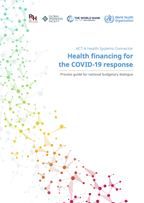Performance-based financing
Overview
Improving the performance of health care providers is a complex challenge that requires the deployment of a multi-faceted strategy. One policy option that has regularly been considered consists of paying providers – at least in part – on the basis of their performance to meet targets or undertake specific actions. Such option is generically termed “Pay-for-performance” (P4P).
In many low- and middle-income countries (LMICs), Performance-Based-Financing (PBF) programmes are implemented with the support of development partners. A key feature of performance-based financing is that payments are conditional on performance, often defined in terms of process or output indicators, adjusted by some measure of quality. It can be contrasted with the line-item budget approach for funding facilities, which finances a health facility through inputs such as medicines or personnel.
Benefits of performance-based financing
- It helps sharpen the focus of health system objectives when stakeholders choose payment indicators. That is why it is important to be careful in selecting indicators because they send an important signal to health providers about priorities. In this process it is important to ensure that incentivized services are those services that reflect the national burden of disease and international evidence. For example, if cardiovascular diseases cause the most significant morbidity and mortality, then hypertension control at primary care level can be a good area of focus for performance-based financing.
- It generates better data and information for performance monitoring as providers have incentives to ensure good record keeping and a purchaser must use data to make payments. Decisions on allocation of resources and data are no longer detached from each other, which generally improves the quality of data and its use. A strong health information system is viewed as an important element of the overall health system.
- It strengthens the dialogue between purchasers and providers as they, together with other stakeholders, choose priority health services and indicators for monitoring the services. These indicators, which are reported and verified on a regular basis, serve as the basis for making payments. Purchasers no longer simply follow a predetermined budget or reimburse bills, they use available information to make decisions on who and how much to pay.
- Viewing performance-based financing as a way to strengthen strategic purchasing helps to ensure that PBF goes beyond a particular project and becomes part of the country’s health system. It clarifies the link between PBF initiatives and efforts to achieve the universal health coverage goals.
Challenges
However, it is also important to mention that PBF effectiveness depends critically on its connections with the wider environment of purchaser–provider relations and the overall health system reform dynamic. As a stand-alone programme, it may not live up to its full potential and may raise concerns in terms of sustainability.
Policy questions to strengthen or put in place pay for performance
For countries that have not yet introduced P4P modalities:
- What are the main barriers to improved health outcomes? How is P4P expected to address these barriers? Are there significant demand-side challenges that should be addressed simultaneously?
- How would the P4P modality relate to and complement the underlying provider payment systems? Will it blend with other existing payment methods?
- What are the prerequisite for the P4P modality to be implemented as per design and to achieve its intended objective? Reversely what are the bottlenecks which hamper it to operate as expected?
- What are the conditions for the P4P modality to be sustainable in the long run (especially when it is externally funded)? What is the P4P institutionalization pathway?
In countries where P4P is in place:
- What are the conditions for the P4P modality to be flexible and adapt incentives it creates to the ever-evolving needs?
- In LMICs, what should be done (and reversely what should be avoided) to ensure a smooth transition from an externally funded project to a domestically-funded mechanism that blends into the existing payment system, but also in the institutional and legal frameworks?
Publications
All →Financing common goods for health
Common Goods for Health (CGH) are the core population-based functions or interventions that are essential to the health and well-being of entire societies....

Health financing for the COVID-19 response
This Process Guide lays out a sequenced set of analytics and actions to support reorienting budgetary arrangements to facilitate the ability of national...
Health programmes are able to target health interventions for specific diseases or populations, and historically, countries have relied heavily on them...
External Publications
Activities
Related health topics
Contact Us
